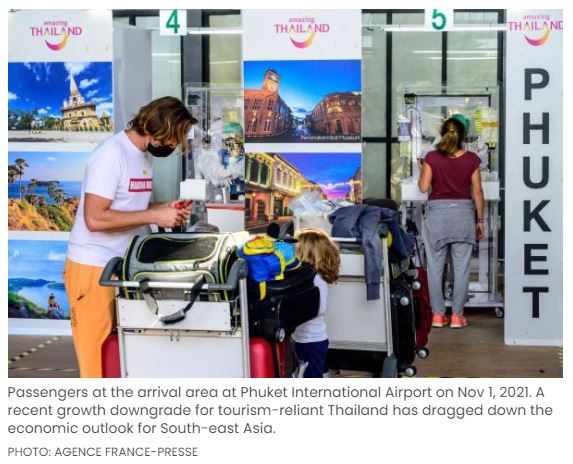ADB pares S-E Asia growth outlook on Omicron spread, warns of further risk from China outbreaks
SOUTH-EAST Asia could see softer economic growth in 2022, as the Asian Development Bank (ADB) pared its full-year gross domestic product (GDP) forecast to 4.9 per cent, from 5.1 per cent previously.
Growth is expected to pick up to 5.2 per cent in 2023, as the recovery is gaining momentum “in most of the sub-region’s economies as Covid-19 vaccination coverage increases and mobility restrictions are eased”, the ADB said in its latest Asian Development Outlook report on Wednesday (Apr 6).
But ADB chief economist Albert Park warned in a briefing that “while the baseline forecasts are relatively good, several downside risks cloud the horizon”, such as sharper-than-expected rate hikes from the US Federal Reserve, which could shave 0.2 percentage point off developing Asia’s growth in 2022 and 0.1 point in 2023, compared with the base case.
The ADB estimates also do not account for ongoing Covid-19 outbreaks in China, which continues to pursue a drastic strategy of virus elimination and mass lockdowns.
South-east Asia’s outlook is just under the overall projection for developing Asia, where the economy is expected to grow by 5.2 per cent in 2022 and 5.3 per cent in 2023.
Excluding the advanced economies of Hong Kong, Taiwan, South Korea and Singapore, growth is expected to come in at 5.4 per cent in 2022 and 5.5 per cent in 2023.
Inflation in both developing Asia overall, and South-east Asia in particular, is tipped to rise to 3.7 per cent in 2022, then ease to 3.1 per cent in 2023, amid the ongoing Russian invasion of Ukraine.
The downward revision of the South-east Asia forecasts was attributed mainly to the spread of the Omicron variant in early 2022.
Abdul Abiad, director of the ADB’s macroeconomic research unit, added at the briefing that “a big chunk of it is actually Thailand”, where the forecast was cut from 4 per cent to 3 per cent on the back of the pandemic impact on the kingdom’s tourism-reliant economy.
Meanwhile, the report has predicted that growth in China would cool to 5 per cent in 2022 – below the official target of “around 5.5 per cent” – and 4.8 per cent in 2023.
The latest Covid-19 outbreaks in China are “certainly a concerning factor and could, if it got out of hand, lower growth in the coming year”, Park said, in reply to a question from The Business Times.
He noted that developments in China affect “aggregate demand for many goods” globally, but any impact on South-east Asia “would probably be a bit more pronounced”, given the region’s trade, investment and supply chain links.
At the same time, supply chains and logistics “proved to be more efficient in developing Asia than in the rest of the world”, said Matteo Lanzafame, an ADB senior economist, so “they are not as affected as other economies which are in the downstream” of the value chain.
And, despite the moderation in the Chinese economy, which faces structural headwinds such as a rapidly ageing population, Park said its size means that “even at slower growth rates, its contribution to total regional growth will still be so key for a long time going forward”.
Lanzafame added that the ADB team’s baseline assumption is for the outbreaks in China to be brought under control and “it’s not going to derail the recovery” in that market, with economic activity to pick up over the course of the year.
Separately, direct impact of the war in Ukraine will likely be limited to the neighbouring Caucasus and Central Asia region, according to a special chapter of the ADB’s report.
But developing Asia will still take a hit from supply chain snarls and higher food and fertiliser prices, as well as higher energy prices that “will aggravate inflation and pose challenges for growth”.
“The Russian invasion of Ukraine might speed up the green transition in developing Asia… In the short term, however, energy security concerns might boost the extraction of fossil fuels where they are available,” the report added.
Source: https://www.businesstimes.com.sg/asean-business/adb-pares-s-e-asia-growth-outlook-on-omicron-spread-warns-of-further-risk-from-china


 Thailand
Thailand




